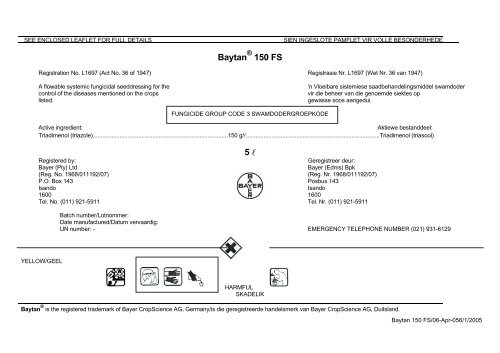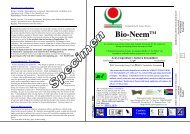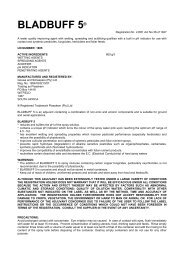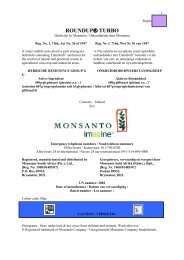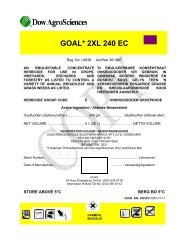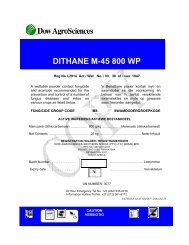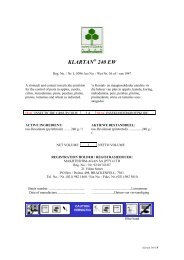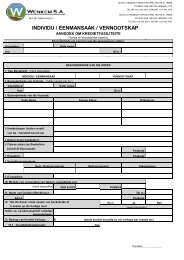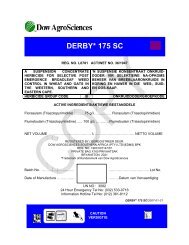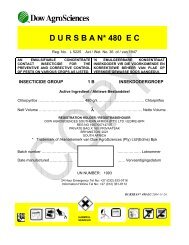Baytan 150 FS.pdf - Wenkem
Baytan 150 FS.pdf - Wenkem
Baytan 150 FS.pdf - Wenkem
Create successful ePaper yourself
Turn your PDF publications into a flip-book with our unique Google optimized e-Paper software.
SEE ENCLOSED LEAFLET FOR FULL DETAILS SIEN INGESLOTE PAMFLET VIR VOLLE BESONDERHEDE<br />
<strong>Baytan</strong> ® <strong>150</strong> <strong>FS</strong><br />
Registration No. L1697 (Act No. 36 of 1947) Registrasie Nr. L1697 (Wet Nr. 36 van 1947)<br />
A flowable systemic fungicidal seeddressing for the 'n Vloeibare sistemiese saadbehandelingsmiddel swamdoder<br />
control of the diseases mentioned on the crops vir die beheer van die genoemde siektes op<br />
listed. gewasse soos aangedui.<br />
FUNGICIDE GROUP CODE 3 SWAMDODERGROEPKODE<br />
Active ingredient: Aktiewe bestanddeel:<br />
Triadimenol (triazole)......................................................................................<strong>150</strong> g/l.....................................................................................Triadimenol (triasool)<br />
5 l<br />
Registered by: Geregistreer deur:<br />
Bayer (Pty) Ltd Bayer (Edms) Bpk<br />
(Reg. No. 1968/011192/07) (Reg. Nr. 1968/011192/07)<br />
P.O. Box 143 Posbus 143<br />
Isando Isando<br />
1600 1600<br />
Tel. No. (011) 921-5911 Tel. Nr. (011) 921-5911<br />
YELLOW/GEEL<br />
Batch number/Lotnommer:<br />
Date manufactured/Datum vervaardig:<br />
UN number: - EMERGENCY TELEPHONE NUMBER (021) 931-6129<br />
HARMFUL<br />
SKADELIK<br />
<strong>Baytan</strong> ® is the registered trademark of Bayer CropScience AG, Germany/is die geregistreerde handelsmerk van Bayer CropScience AG, Duitsland.<br />
<strong>Baytan</strong> <strong>150</strong> <strong>FS</strong>/06-Apr-056/1/2005
2<br />
<strong>Baytan</strong> ® <strong>150</strong> <strong>FS</strong><br />
Reg. No. L1697 (Act No. 36 of 1947)<br />
A flowable fungicidal seeddressing for the control of stinking smut (Tilletia) and loose smut (Ustilago) on irrigated<br />
wheat and wheat in the Winter Rainfall Region, loose smut (Ustilago avenae) on oats and for the control of covered<br />
and loose smut (Ustilago) and the suppression of powdery mildew (Erysiphe graminis), rust (Puccinia hordei) and<br />
leaf spot (Rhynchosporium secalis) on barley, control of cob and tassel smut (Sphacelotheca reiliana) on maize and<br />
the control of black root rot (Thielaviopsis basicola) on tobacco when applied as a seedbed drench.<br />
Active ingredient:<br />
Triadimenol (triazole) .................... <strong>150</strong> g/l<br />
FUNGICIDE GROUP CODE 3<br />
Registered by: Bayer (Pty) Ltd<br />
(Reg. No. 1968/011192/07)<br />
P O Box 143<br />
ISANDO<br />
1600<br />
<strong>Baytan</strong> ® is the registered trademark of Bayer CropScience AG, Germany.<br />
x<br />
HARMFUL<br />
<strong>Baytan</strong> <strong>150</strong> <strong>FS</strong>/06-Apr-056/1/2005
WARNINGS:<br />
3<br />
• TREAT ONLY SEED THAT IS TO BE USED FOR PLANTING PURPOSES. NEVER USE TREATED SEED<br />
FOR FEEDING.<br />
• Use <strong>Baytan</strong> <strong>150</strong> <strong>FS</strong> only for the treatment of high quality certified seed.<br />
• Poisonous when absorbed through the skin or swallowed or inhaled.<br />
• Toxic to fish and wildlife.<br />
• Store away from food and feedstuffs.<br />
• Keep out of reach of children, uninformed persons and animals.<br />
• In case of poisoning CALL A DOCTOR AND MAKE LABEL AVAILABLE TO HIM/HER.<br />
• There may be a delay in the emergence of seed treated with <strong>Baytan</strong> <strong>150</strong> <strong>FS</strong>. This is only of temporary nature<br />
and has been shown to be of no economic significance under normal growing conditions.<br />
• Optimal seedbed conditions are necessary for rapid germination and emergence of small grains. Thorough<br />
seedbed preparation is essential for success. It is known that reduced crop emergence can be caused by<br />
adverse factors such as: a very dry, fluffy and cloddy seedbed, soils that tend to crust (surface compaction),<br />
water logging, drilling/sowing too deep (more than 50 mm) or too shallow (less than 20 mm) use of seed with<br />
low germination capacity and vigour etc. The effect of these negative environmental- and seed conditions may<br />
be accentuated, when seed is treated with <strong>Baytan</strong> <strong>150</strong> <strong>FS</strong>.<br />
• ALTHOUGH THIS REMEDY HAS BEEN EXTENSIVELY TESTED UNDER A LARGE VARIETY OF<br />
CONDITIONS THE REGISTRATION HOLDER DOES NOT WARRANT THAT IT WILL BE EFFICACIOUS<br />
UNDER ALL CONDITIONS BECAUSE THE ACTION AND EFFECT THEREOF MAY BE AFFECTED BY<br />
FACTORS SUCH AS ABNORMAL SOIL, CLIMATIC AND STORAGE CONDITIONS; COMPATIBILITY WITH<br />
OTHER SUBSTANCES NOT INDICATED ON THE LABEL AND THE OCCURRENCE OF RESISTANCE OF<br />
THE DISEASE AGAINST THE REMEDY CONCERNED AS WELL AS BY THE METHOD, TIME AND<br />
ACCURACY OF APPLICATION. THE REGISTRATION HOLDER FURTHERMORE DOES NOT ACCEPT<br />
RESPONSIBILITY FOR DAMAGE TO CROPS, VEGETATION, THE ENVIRONMENT OR HARM TO MAN OR<br />
ANIMAL OR FOR LACK OF PERFORMANCE OF THE REMEDY CONCERNED DUE TO FAILURE OF THE<br />
USER TO FOLLOW THE LABEL INSTRUCTIONS OR TO THE OCCURRENCE OF CONDITIONS WHICH<br />
COULD NOT HAVE BEEN FORESEEN IN TERMS OF THE REGISTRATION. CONSULT THE SUPPLIER IN<br />
THE EVENT OF ANY UNCERTAINTY.<br />
PRECAUTIONS:<br />
• Do not inhale mist.<br />
• Wash with soap and water immediately after use.<br />
• Do not eat, drink or smoke whilst applying or before washing hands and face.<br />
• Destroy empty container by perforation and flattening and never use for any other purpose.<br />
• Prevent contamination of food, feedstuffs, drinking water and eating utensils.<br />
• Handle treated seed carefully and clearly mark the bags which contain treated seed "POISONOUS" and never<br />
use this bag again for other purposes.<br />
SYMPTOMS OF HUMAN POISONING:<br />
No known symptoms.<br />
<strong>Baytan</strong> <strong>150</strong> <strong>FS</strong>/06-Apr-056/1/2005
FIRST AID TREATMENT:<br />
4<br />
Remove patient from source of poisoning (to well ventilated area) and keep him quiet and reassured.<br />
Remove contaminated clothing and rinse contaminated body area thoroughly with plenty of soap and cold water. Do<br />
not rub skin. Flush contamination out of eyes with clean water for 15 minutes. If water diluted mixture has been<br />
swallowed, induce vomiting by tickling the back part of the throat. If concentrate has been swallowed, firstly give<br />
copious quantities of either beaten egg white starch solution or Milk of Magnesia before inducing vomiting. Repeat<br />
until vomit fluid is clear and free from smell of poison. Administer artificial respiration or closed chest cardiac<br />
massage if necessary. Do not apply direct mouth to mouth respiration. Never give anything by mouth to an<br />
unconscious person.<br />
TAKE THE PATIENT TO THE NEAREST PHYSICIAN IMMEDIATELY.<br />
NOTE TO PHYSICIAN<br />
Treat symptomatically.<br />
RESISTANCE MANAGEMENT:<br />
For resistance management, <strong>Baytan</strong> <strong>150</strong> <strong>FS</strong> is a group code 3 fungicide. Any fungus population may contain<br />
individuals naturally resistant to <strong>Baytan</strong> <strong>150</strong> <strong>FS</strong> and other group code 3 fungicides. The resistant individuals can<br />
eventually dominate the fungus population if these fungicides are used repeatedly. These resistant fungi may not be<br />
controlled by <strong>Baytan</strong> <strong>150</strong> <strong>FS</strong> or any other group code 3 fungicides.<br />
To delay fungicide resistance:<br />
• Avoid exclusive repeated use of fungicides from the same fungicide group code. Alternate or tank mix<br />
with registered products from different fungicide group codes.<br />
• Integrate other control methods (chemical, cultural, biological) into disease control programs.<br />
For specific information on resistance management contact the registration holder of this product.<br />
DIRECTIONS FOR USE: USE ONLY AS DIRECTED<br />
Large quantities of seed are conveniently treated in automatic seeddressing machines. The machines should be<br />
checked at intervals to ensure that the correct quantity of <strong>Baytan</strong> <strong>150</strong> <strong>FS</strong> is used.<br />
Small quantities of seed may be treated in a manually operated drum suspended from a support by two pivots. The<br />
drum should not be filled more than two-thirds with seed and after adding the required quantity of <strong>Baytan</strong> <strong>150</strong> <strong>FS</strong><br />
and closing the lid, rotate the drum slowly for 3-5 minutes to ensure that each seed is evenly covered with the<br />
seeddressing.<br />
So as to ensure thorough coverage of the seed with <strong>Baytan</strong> <strong>150</strong> <strong>FS</strong> when using an automatic seed dressing<br />
machine <strong>Baytan</strong> <strong>150</strong> <strong>FS</strong> must be diluted with water in a 1:1 ratio. This dilution with water (<strong>150</strong> ml <strong>Baytan</strong> <strong>150</strong> <strong>FS</strong> +<br />
<strong>150</strong> ml water per 100 kg seed) will have no adverse effect on germination or storage of seed.<br />
Seed may be treated with <strong>Baytan</strong> <strong>150</strong> <strong>FS</strong> immediately before planting, but can also be treated earlier and stored until<br />
planting time without germination and fungicidal activity being affected.<br />
Mixing instruction:<br />
Tobacco: First add a little water to the required volume of <strong>Baytan</strong> <strong>150</strong> <strong>FS</strong> and mix well before adding to the correct<br />
volume of water. Keep mixture agitated during use.<br />
CROP/DISEASE DOSAGE REMARKS<br />
Wheat:<br />
(Only irrigated and in the<br />
Winter Rainfall Region)<br />
Stinking smut <strong>150</strong> ml/100 kg Ensure complete coverage<br />
<strong>Baytan</strong> <strong>150</strong> <strong>FS</strong>/06-Apr-056/1/2005
(Tilletia), seed of the seed with <strong>Baytan</strong><br />
loose smut <strong>150</strong> <strong>FS</strong>.<br />
(Ustilago)<br />
Barley:<br />
Covered smut <strong>150</strong> ml/100 kg <strong>Baytan</strong> <strong>150</strong> <strong>FS</strong> when used<br />
(Ustilago hordei), seed for the control of Ustilago<br />
loose smut on barley will also suppress<br />
(Ustilago nuda) powdery mildew, rust and<br />
leaf spot.<br />
CROP/DISEASE DOSAGE REMARKS<br />
OATS:<br />
Loose smut <strong>150</strong> ml/100 kg Ensure complete coverage of<br />
(Ustilago avenae) seed the seed with <strong>Baytan</strong> <strong>150</strong> <strong>FS</strong>.<br />
5<br />
Maize:<br />
Cob and tassel 330 ml/100 kg Ensure complete coverage of<br />
smut seed the seed with <strong>Baytan</strong> <strong>150</strong> <strong>FS</strong><br />
seeddressing.<br />
Tobacco (seedbeds):<br />
Black root rot 15 ml/100 l Using a watering can fitted with a<br />
(Thielaviopsis basicola) water fine rose, drench the seedbeds 3<br />
weeks after emergence of the<br />
seedlings with the suspension at 2<br />
l/m 2 . Immediately afterwards, drench<br />
the same area with a further 2 l/m 2 of<br />
clean water to leach the fungicide<br />
into the root zone.<br />
NOTE:<br />
Should surface compaction of the soil take place after planting and before emergence, this must be broken by means<br />
of a suitable implement.<br />
© Bayer (Pty) Ltd. All unauthorised reproduction of this label is forbidden.<br />
<strong>Baytan</strong> <strong>150</strong> <strong>FS</strong>/06-Apr-056/1/2005


